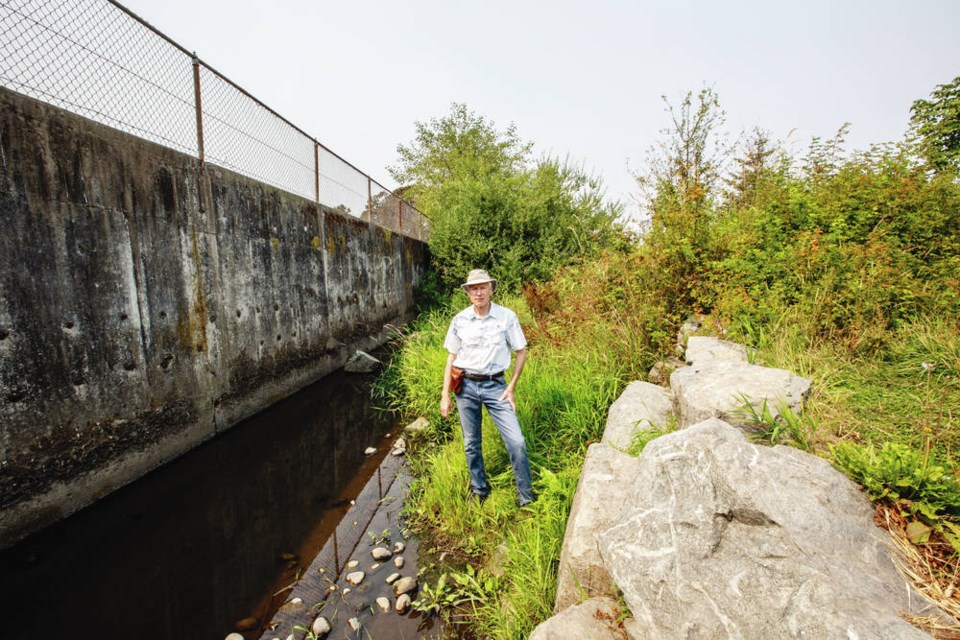Bowker Creek, the eight-kilometre urban waterway meandering through the region’s largest municipalities and mostly hidden by underground culverts after more than a century of development, is starting a long road to recovery this fall.
A portion of the creek, where it spills into the ocean near Oak Bay Marina, is being prepared for the return of chum salmon, which haven’t been seen since major diversions of the flow began in 1914.
“It’s an exciting time,” said Gerald Harris, director of the Friends of Bowker Creek Society and a long-time fisheries consultant. “This is the beginning of bringing back life and diversity to an important stream right in our neighbourhoods.”
The group of volunteers has been preparing the riparian areas of Bowker Creek near Monteith Street for years and were granted approval by the Department of Fisheries and Oceans for the placement of about 30,000 salmon eggs in February.
Later this month and into September, the Peninsula Streams Society will bring in loads of gravel to prepare the stream bed over a two-block area for chum eggs.
The eggs will be placed in two “salmon condos,” a plastic structure with grates buried in the gravel that will protect the eggs but allow the hatched fry to swim free.
The eggs will be taken from salmon in the Goldstream River during this fall’s spawn and incubated at the Goldstream Hatchery in Langford.
After three years, Harris said, chum salmon should start coming back from the ocean as adults to spawn and start their remarkable life cycle in South Oak Bay.
“We have some work to do before those adult salmon come back,” he said.
Stream sides will have to be improved with plants that provide shade for the young chum and gravel shoring to act as natural filters to help purify and cool the water.
The Friends of Bowker Creek had to provide the DFO with water-quality samples and flow data during the November to April period and show the work they’ve done to improve the spawning area before approval was given, said Harris.
He said continuing improvements will not only make sure the chum salmon thrive, but could also pave the way for other fish stocks in the future.
The creek, named for John Sylvester Bowker, an American who settled in the area in the 1860s, once supported coho salmon and cutthroat trout. First Nations middens of camp debris along its path have been dated back 2,500 years.
The society’s Bowker Creek Blueprint outlines a 100-year plan for the length of the waterway, which has generally been championed by councils in Oak Bay, Victoria and Saanich as a part of the decision-making process around future developments.
It’s an ambitious look forward on improving rainwater and storm-drain management around the creek and to eventually “daylight” the entire eight kilometres, which begins in springs and underground gravel beds that collect winter rainfall on the University of Victoria campus. There is also an arm of the stream, connecting near North Dairy Road on the Saanich-Victoria border, generated from springs at Cedar Hill Golf Course.
About 60 per cent of Bowker Creek is underground and flowing through culverts, including under the parking lot at Hillside mall, through Firefighter’s Park in Oak Bay and other urban neighbourhoods.
Harris said the blueprint plan was developed so current and future generations of municipal leaders can be mindful of redevelopments around the creek. He said it’s also a reminder of the importance of natural ecosystems amid the crisis surrounding climate change.
The last chum salmon were documented around Royal Jubilee Hospital in 1914, which, Harris said, coincided with the building of the culvert system underneath Firefighters Park in Oak Bay.
Bowker Creek ran through a huge gully there, but the site was also used as a garbage dump for the growing community, he said. It was eventually filled in, the creek piped through, and it’s now used as a park.
Harris worked for the DFO in the 1970s and had a 13-year career in fisheries consulting. He has written a booklet for the 91ԭ�� Aquarium publication Waters, which documented 91ԭ��’s historic streams.
He said the society’s vision is managing human uses and natural areas in the Bowker watershed to “minimize runoff and pollution, making Bowker Creek a healthy stream that supports habitat for native vegetation and wildlife, and provides a community greenway to connect neighbourhoods.”



